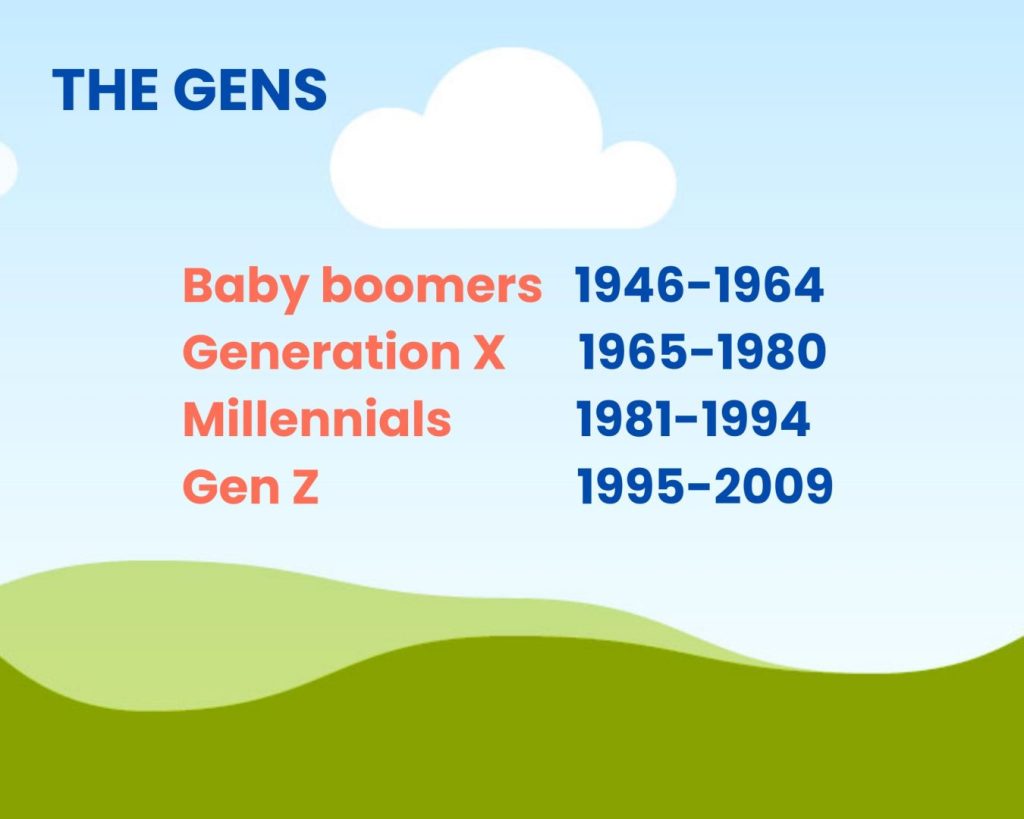We’re all now familiar with the different generations. Maybe you’ve seen the TikTok videos showing how they react differently to stubbing a toe (the “snowflake” Gen Z rolling on the floor in exaggerated anguish while live-streaming it). There are many stereotypes, but marketers need to take Boomers, Gen X, Millennials and Gen Z seriously.
We live in an age of ever-finer audience segmentation and targeting. There are very real differences between the generations, specifically in relation to their relationship with media and technology. Let’s take a deeper look.
Baby boomers (born 1946-1964)
This generation tends to equate work with self-worth and long-term financial security. They lived through hard times and believe that prestige or value must be earned and deserved within an established hierarchy. For this reason, they believe strongly in brand loyalty if a brand serves them well.
Boomers also grew in a world where things moved more slowly and where tradition was important. Their communication was “slow:” print newspapers, telephone conversations, TV and longer texts. They are accustomed to email, but probably prefer it to instant messaging for things that really matter.
Marketing to Boomers
Selling to Boomers means understanding their lifestyle and habits. They have disposable income, but are careful how they spend it. If they find something they like, they are unlikely to change it unless the service or quality declines. Upselling and loyalty programs work well with this generation, but be aware that they prefer their customer service more personalized: face-to-face or by phone call.
It’s not true that Boomers are techphobic. They see the advantages as well as any other generation, but they do use their tech differently. Social media is useful for entertainment and staying in touch with friends, but Boomers may be suspicious of ads (interrupting their personal space!) or eCommerce posts (scammers?) on such platforms.
US Boomers spend $3.2 trillion annually according to AARP and have $15 trillion in assets. Around 50% of all consumer expenditure is Boomer spending, but digital marketing budgets often tend to discount the audience. They are a natural audience for luxury or high-end products and services such as cruises, fine wine, exclusive furniture or even that Harley they always dreamed of.
Generation X (born 1965-1980)
The story about Gen X is that they grew up more independent because their parents were working. This independence reflects not only self-sufficiency but also an individualistic way of thinking. They like to form their own opinions rather than accept the hierarchies and systems of their parents.
Gen X are a tough audience because they tend to be skeptical or cynical. They grew up with mass media and advertising, learning its language and codes. Engaging Gen X means recognizing and appealing to their perceived independence of thought and action. They need to feel that they make the decisions.

Tips for Gen X messaging
User-generated content can work well because it invites Gen X to participate rather than be consumers. They may also be more likely to offer comments on social media posts or by email because they grew up before the Internet impacted the use of longer written forms. They have things to say and expect to be taken seriously.
Around 80% of this generation are on Facebook and Twitter – comparable with Millennials – and are comfortable with digital tech, though their suspicion of marketing in general may mean they are less receptive to efforts on these channels.
Email remains an effective tool with Gen X because they were first adopters and still believe in the importance of text. They check their accounts regularly, but remember: you’ll need to avoid cheesy or predictable subject lines and CTAs. They will delete anything that looks too like marketing.
Another marketing option with Gen X is traditional mail. Yes, really. Around 86% of this generation checks their mailbox daily because they still prefer to receive physical bills, official letters and birthday or Christmas cards. A letter or an offer received at home carries more weight (literally) than one of a thousand Facebook ads.
Millennials (born 1981-1994)
Millennials, like Gen X, tend to appreciate flexibility and choosing their own options. The difference is that they were more influenced and at a younger age by the birth of the Internet. It is a generation with a lot of entrepreneurial spirit because it entered the employment market in a recession and had to learn quickly. This makes them very tech and media-savvy.
One effect of the early Internet was that social issues could be transmitted much faster and more effectively. The result was that many Millennials adopted causes that would steer their opinions and actions. Values and principles drive Millennial decision-making, They expect their brands to feel the same as they do about LGBT+ issues, climate change, mental health and equal rights in general.
Do not underestimate Millennial spending power, which amounts to $200b annually. Do, however, understand how and where they like to spend. In-store shopping is less popular among Millennials than Gen X for example. Online shopping has been wholeheartedly embraced on the other hand, and decisions are heavily influenced by social media coverage (paid and organic.) Conversely, traditional marketing media and techniques (TV, print) are less effective for this generation.
Millennials and tech
Millennials are 21% more likely to own a Mac or stand in line for a new iPhone release. They also like online dating apps and drones. In other words, they are highly receptive to new tech and keen to adopt innovative ways to consume media or spend money. Millennials are also especially influenced by the group nature of social media, so peer reviews are highly influential in decision-making. Around 68% or Millennials don’t make a serious buying decision without discussing it with peers (often online).
Despite their love of new tech, Millennials are also a little old school. Around 93% of them listen to the radio for 11 hours each week – more than Gen Xers or Baby Boomers. Let’s remember that radio advertising can be very adaptable with a little creativity. You can set your ad on Mars or in the future or in the back of a speeding car with a great script. Podcasts are also increasingly popular and influential because they can be consumed anywhere and anytime.
Millennials are also more likely to interact with brands than the earlier generations, so encourage this with techniques such as quizzes, surveys, user-generated content, scoring systems and gamification. They appreciate receiving discounts or exclusive offers in return for their brand loyalty.
Gen Z (born 1995-2009)
The oldest Gen-Zs are about 24 years old, so the generation as a whole is becoming increasingly significant as a consumer group. Around 20% of the current US population is Gen Z and this will inevitably change the way brands approach marketing.
As you might expect, there’s some crossover with Millennials but Gen Z tends to have a greater necessity for personal fulfillment in their work and in their general activity. They not only respect but expect a brand to have a sincere corporate social responsibility program – not only on paper but in reality. It is a highly diverse generation in all senses, so acceptance and inclusivity are sacrosanct. For example:
· 69% will pay more if employees and suppliers are treated fairly.
· 66% will pay more if the brand tries to have a positive impact on society.
· 61% will pay more if the brands use inclusive practices.
· 60% will pay more for a business that practices sustainability.
More than anything, Gen Z wants to be understood and appreciated on its own terms. It is the generation most alert to mental health challenges, with 29% admitting to regular anxiety. They worry. They’re sensitive. Older generations have been quick to mock such tendencies, but they are real and this growing consumer segment will not tolerate brands that don’t recognize their needs.
To put it another way, Gen Z wants personalization and will gladly supply their personal data to enable better-targeted and customized offers. For example, Gen Z likes a company that allows them to design their own shoes using an online style builder. If they leave a comment on your social feed or website, they expect you to engage with a genuine reply.

Gen Z habits
This generation is more likely than other generations to embrace the metaverse (around 83% of them), virtual reality and augmented reality. Does your clothing company offer a virtual changing room to try new garments? Gen Z would like that kind of thing. In these non-analog worlds, they are also more likely to look for options to pay in crypto. Along with Millennials, they account for 94% of all crypto purchases.
One of the biggest challenges when marketing to Gen Z is understanding their very different frames of reference. No doubt you’ve heard the “OK, Boomer” meme, which younger generations direct mockingly to their parents and grandparents who simply don’t understand the new digital world. For example, 90% of Gen Z are gamers, which is a world with its own vocabulary and conventions. Do you understand that world? Can you reference it in your marketing?
At the same time, Gen Z is heavily into “nostalgia,” with 19% looking to the past for inspiration. The music and culture of the 1990s is like the music and culture from the 1960s for Gen X: a more “real” time before the Internet. They’re not interested in history as such, but in the idea of a better past. This can be useful in structuring marketing and branding. Check out Pepsi’s new 2023 logo, which looks very much like the 1980s version.
Read more about Gen Z here.
Generation Alpha (born 2010-2024)
This generation is still mostly too young to be a consumer segment, but it will certainly be a distinctive one. No generation has been more saturated with online content and tech-reliant media. Early indicators are that Gen A prefers video and voice to text. Indeed, texts longer than twenty words may be the worst possible way to reach them.
Concentration spans may also be an issue. If a fifteen-minute YouTube video is at the upper limit of what they will consume, a fifteen-second social media ad may be an eternity. Marketers will need to learn micro-messaging for a generation whose concept of narrative is more fragmented than ever before.
Whichever generation you’re marketing towards, the message is the same: accurate targeting based on clear understanding. Data is essential to that understanding, and data is the foundation of everything Bucksense does.










